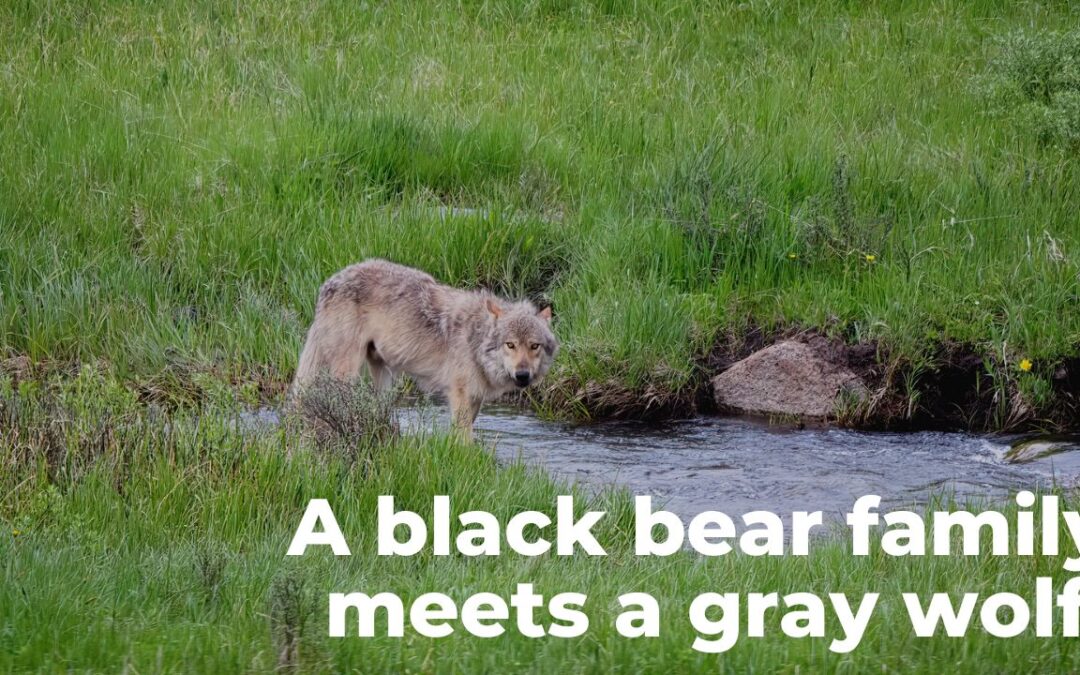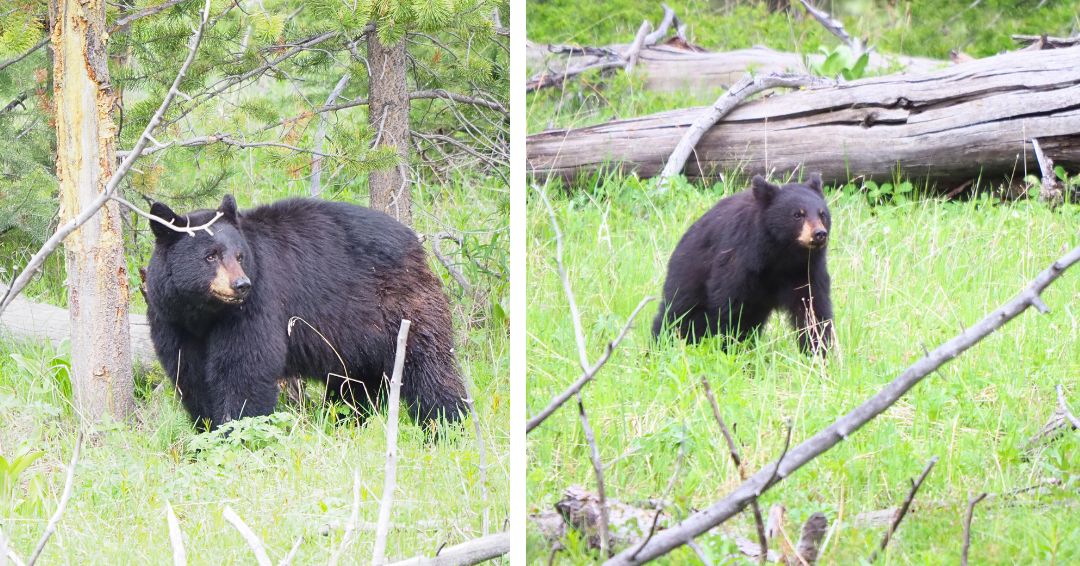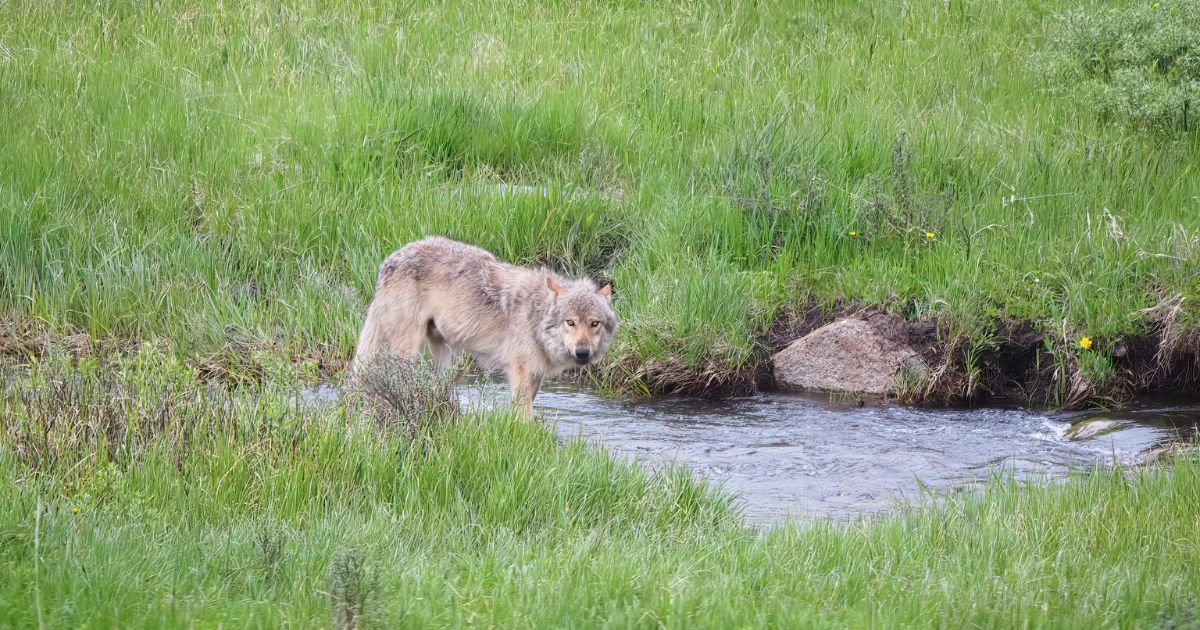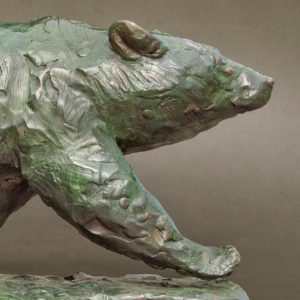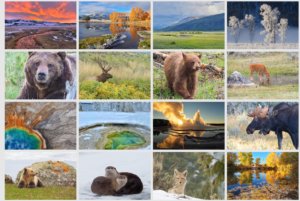Here's a fun Yellowstone wildlife watching moment!
I headed into the park a few evenings ago in hopes of seeing one (or both) of a couple of different grizzly bear sows with cubs of the year that have been frequently seen from the road.
Not having any luck, I headed home past Canyon and over Dunraven Pass, where I came across a black bear sow with two yearling cubs grazing peacefully.
As the light started to wane and the bears drifted out of sight behind the tall sagebrush, I decided to meander on, thinking of home, and a late dinner.
But Yellowstone had something else in mind!
Wildlife watching in Yellowstone doesn't always turn out how you might expect.
Moments later, I spotted movement out of the corner of my eye and drew a deep breath; a gray wolf was trotting through the tall June-green grass towards the road, crossing just behind the car and disappearing into the trees.
Most of our Yellowstone wolf sightings are from a great distance, only visible through binoculars and spotting scopes, so to see one so close was pretty exciting.
I pulled over in a nearby picnic area and waited to see if the wolf would appear. Sure enough, I heard the high pitched chirp alarm of a ground squirrel, telling me exactly where the wolf was traveling. Moments later, it emerged into an open meadow along the creek below, and stopped to get a drink from the creek.
It was an incredible moment. Not a single other soul knew the wolf was there, for which I was grateful. I was able to have a few minutes alone in Yellowstone, quietly observing this magnificent being from a respectful distance. Roadside magic can be hard to come by in Yellowstone in the busy roadside scenes of summer, but this was one moment when I felt the vastness, the wildness of Yellowstone.
On a whim, I went back up the road and ended up observing the wolf crisscrossing back and forth , and in and out of sight, as if hunting.
The wolf was generally heading back in the same direction as the black bear sow and cubs, and I was curious to see if they would encounter each other. Wanting to give the wolf space to travel and cross the road unhindered, I drove ahead, found a nice pull out, and waited, a steady rain beginning to fall. I couldn’t see either the bears or the wolf from my pullout. I turned off the engine, rolled down the windows, watched, and listened.
After just a few moments, I heard a loud, scratch-scratch-scratching sound, and saw one of the cubs scrambling up a dead lodgepole pine tree.
A ha! I thought; there’s the wolf.
I couldn’t see the wolf or the sow and second cub, hidden behind a hill and new growth of lodgepole pine, but had fun imagining the encounter, and watching the cub in the tree as it watched what was unfolding below. Eventually, the wolf must have moved on and the scene safe and the bear cub climbed back down the tree.
Well, I wasn’t expecting that to happen when I went out looking for bears this evening!
Three things helped me have this Yellowstone wildlife watching experience: animal alarms, curiosity, and sitting still.
The first was understanding the alarms of the squirrel, so that I knew where to find the wolf.
The second was being curious: Where is the wolf going? Why is it by itself? What’s going to happen next? Asking questions instead of just snapping a picture and moving on can lead to some pretty interesting observations.
Finally, I picked a spot and waited, and used my senses to watch and listen for changes on the landscape, rather than driving up and down the road with senses dulled inside a vehicle. Had I just kept driving to find the wolf I would have missed the sound of the cub climbing the tree and likely the entire encounter.
(These are a few of our tips in our free wildlife watching guide. Click here to grab a copy).
So many mysteries even still. Where was the other cub? What was the encounter like? Did they see each other or did the bears smell the wolf? Did momma bear give a signal to the cubs or did they sense the wolf on their own? It’s addictive, really, observing and wondering what goes on in the lives of the wild animals that call Yellowstone home.
A few important notes:
At all times, I was either in my vehicle or more than 100 yards away from the bears, and the wolves. These images were photographed with a telephoto lens, and cropped in post processing.
I felt comfortable driving up the road to another pull out because the wolf was criss-crossing rather than traveling directly on the road, and I could drive along with regular traffic and not disturb it. While it’s tempting to drive slowly along following the animal as they travel the road, it’s quite dangerous for the animals and for people, increasing the chance of an accident, or the animal getting struck by a vehicle.
Life is hard enough as a wild animal in Yellowstone; it’s critically important for us to observe and enjoy them while giving them space to live their lives.
When was a time another animal clued you in to something else going on? Or when your curiosity led you so something amazing? Drop us a message and let us know at the button on the bottom right!
Want to know more about how the alarms of squirrels and birds can clue you in to the presence of animals like wolves and bears? Learn how in the webinar Secrets of Animal Language.
Images and video © Jenny Golding/A Yellowstone Life

